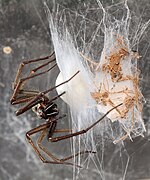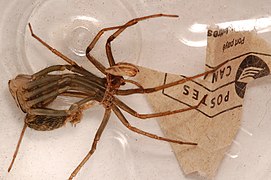| This article may lack focus or may be about more than one topic. In particular, the species has now been split into three again, so separate articles are needed. Please help improve this article, possibly by splitting the article and/or by introducing a disambiguation page, or discuss this issue on the talk page. (April 2020) |
| Giant house spider | |
|---|---|

| |
| Scientific classification | |
| Domain: | Eukaryota |
| Kingdom: | Animalia |
| Phylum: | Arthropoda |
| Subphylum: | Chelicerata |
| Class: | Arachnida |
| Order: | Araneae |
| Infraorder: | Araneomorphae |
| Family: | Agelenidae |
| Genus: | Eratigena |
| Species: | E. atrica |
| Binomial name | |
| Eratigena atrica (C. L. Koch, 1843) | |

| |
| Synonyms | |
| |
The giant house spider has been treated as either one species, under the name Eratigena atrica, or as three species, E. atrica, E. duellica and E. saeva. As of April 2020, the three species view was accepted by the World Spider Catalog. They are among the largest spiders of Central and Northern Europe. They were previously placed in the genus Tegenaria. In 2013, they were moved to the new genus Eratigena as the single species Eratigena atrica. In 2018, the three separate species were restored. The bite of these species does not pose a threat to humans or pets, and they are generally reluctant to bite, preferring instead to hide or escape.
Description
The two sexes do not differ in coloration or markings. Its coloration is mainly dark brown. On its sternum is a lighter marking, with three light spots on each side that form an arrow-like shape pointing toward the head of the spider. The opisthosoma features a lighter middle line with six "spots" on each side. The giant house spider has the same coloration as the domestic house spider, Tegenaria domestica; it has earthy tones of brown and muddy red or yellow. They also have conspicuously hairy legs, palps, and abdomen. The female body-size can reach 18.5 millimeters (0.73 in) in length, with males having a slightly smaller body at around 12 to 15 millimeters (0.47 to 0.59 in) in length. The female leg-span is typically around 45 millimeters (1.8 in). The leg span of the male is highly variable, with spans between 25 and 75 millimeters (0.98 and 2.95 in) being common.
Its eight eyes are of equal size and are arranged in two rows. As the eyes contain fewer than 400 visual cells, E. atrica can probably only distinguish light and dark.
Taxonomy
The first description of a spider now assigned to this species was by Carl Ludwig Koch in 1843, under the name Tegenaria atrica. Other supposedly different species were described later, including Tegenaria saeva by John Blackwall in 1844, Tegenaria duellica by Eugène Simon in 1875 and Tegenaria gigantea by Ralph Vary Chamberlin and Wilton Ivie in 1935. T. gigantea was synonymized with T. duellica in 1978. The three remaining taxa have been regarded as distinct species, particularly in Britain. Thus Roberts (1995) provides distinguishing characters for T. atrica, T. duellica, and T. saeva, as does Oxford (2008) for T. duellica (as T. gigantea) and T. saeva. Others consider these three as part of a single morphologically variable species, for which the oldest name, and hence the senior synonym, is T. atrica.
A phylogenetic study in 2013 concluded that Tegenaria, as then defined, was not monophyletic, and split off some species, including T. atrica, into the newly created segregate genus Eratigena. The study also consolidated the various giant house spider species into one species, E. atrica. A subsequent genetic study of E. atrica specimens determined that there were three distinct morphological groups, leading to the restoration of three separate species: E. atrica, E. duellica, and E. saeva.
Distribution and habitat
E. atrica is found in Europe, Central Asia and Northern Africa. It was unwittingly introduced to the Pacific Northwest of North America circa 1900 due to human activity and has strongly increased in numbers for the last century.
The spider has been found in several European countries in which it was previously not recorded, like Estonia, Latvia, and Lithuania. It is recorded in the checklist of Danish spider species, and is also found in Iceland.
The giant house spider's original habitat consists mostly of caves, or dry forests where it is found under rocks, but it is a common spider in people's homes.
Biology and behavior
The webs built by the giant house spider are flat and messy with a funnel at one end. They do not contain sticky threads. The spider lurks in the funnel until a small invertebrate happens to get trapped in the web, at which point the spider runs out and attacks it. They usually build their webs in corners (on both the floor and ceiling), between boxes in basements, behind cupboards, in attics, or any other area that is rarely disturbed by large animals or humans. They are also often found near window openings.
E. atrica normally lives for two or three years, but lifetimes of up to six years have been observed. While the female only leaves its nest to feed, males can often be seen wandering around houses during the late summer and early autumn looking for a mate. Males can be found from July to October, adult females occur all year.
At least 60 spiderlings emerge from an egg-sac. Unusual for spiders, they are subsocial at this stage: They remain together for about a month, but do not cooperate in prey-capture. The amount of cannibalism correlates with the amount of available food. E. atrica molts seven or eight times before reaching the immature adult state, and after a final molt reaches maturity.
Like most spiders, it possesses venom to subdue its prey. Since E. atrica's bites can penetrate human skin on occasion, the effects of agatoxin might be felt by bite-victims, though these spiders will not bite unless provoked.
With speeds clocked at 0.53 m/s (1.9 km/h; 1.2 mph; 1.7 ft/s), the giant house spider held the Guinness Book of World Records for top spider speed until 1987 when it was displaced by solifugids, although the latter are not true spiders.
Relationship with Eratigena agrestis
A population of giant house spiders is popularly thought to be a deterrent to the establishment of Eratigena agrestis, known in North-America as the "hobo spider", and considered by some to be more likely to bite humans. Giant house spiders may compete with hobo spiders for the same resources. Hobo spiders grow no more than a body size of 15 millimeters (0.59 in) long whereas the larger female giant house spider can have a body size of 18 millimeters (0.71 in), but has proportionately much longer legs.
In popular culture
Humorist David Sedaris has written about his relationship with E. atrica. His essay "April & Paris" documents his growing affection toward and domestic association with giant house spiders, particularly one named April. The essay can be found in the collection When You Are Engulfed in Flames.
Gallery
-
 Female constructing egg-sac
Female constructing egg-sac
-
 Spiderlings
Spiderlings
-
E. atrica can attain a leg span of up to 4 inches (100 mm). This specimen from the USA is approximately 3 inches (76 mm)
-
 A molting E. atrica
A molting E. atrica
References
- ^ "Taxon details Eratigena atrica (C. L. Koch, 1843)". World Spider Catalog. Natural History Museum Bern. Archived from the original on 2016-06-04. Retrieved 2016-04-28.
- ^ Bolzern, Angelo; Burckhardt, Daniel & Hänggi, Ambros (2013). "Phylogeny and taxonomy of European funnel-web spiders of the Tegenaria−Malthonica complex (Araneae: Agelenidae) based upon morphological and molecular data". Zoological Journal of the Linnean Society. 168 (4): 723–848. doi:10.1111/zoj.12040.

- ^ Oxford, Geoff S; Bolzern, Angelo (2018). "Molecules v. Morphology—is Eratigena atrica (Araneae: Agelenidae) One Species or Three?". Arachnology. 17 (7): 337–357. doi:10.13156/arac.2017.17.7.337. S2CID 90843479. Archived from the original on 2021-12-10. Retrieved 2020-03-31.
- ^ "Eratigena Atrica - Giant House Spider". USA Spiders. 2021-02-06. Archived from the original on 2021-02-21. Retrieved 2021-02-06.
- Roberts, Michael J. (1995). Spiders of Britain & Northern Europe. London: HarperCollins. pp. 243–245. ISBN 978-0-00-219981-0.
- Oxford, G. (2008). "Identification of Tegenaria gigantea and T. saeva" (PDF). Newsletter of the British Arachnological Society. 113: 21–23.
- ^ Vibert, Samantha; Salomon, Maxence; Scott, Catherine; Blackburn, Gwylim S.; Gries, Gerhard (June 2017). "Life-history data for the funnel weavers Eratigena agrestis and Eratigena atrica (Araneae: Agelenidae) in the Pacific Northwest of North America". The Canadian Entomologist. 149 (3): 345–356. doi:10.4039/tce.2016.73. ISSN 0008-347X. S2CID 90621685. Archived from the original on 2019-11-02. Retrieved 2020-09-14.
- Checklist of Danish Spiders (Araneae). Version 26-10-2011 (list Archived 2016-03-04 at the Wayback Machine)
- "Skemmukönguló (Eratigena atrica)". Náttúrufræðistofnun Íslands (in Icelandic). Icelandic Institute of Natural History. Archived from the original on 2017-10-11. Retrieved 2017-10-11.
- "Summary for Tegenaria gigantea". srs.britishspiders.org.uk. Archived from the original on 2017-10-05. Retrieved 2020-09-10.
- Pourié, Grégory & Trabalon, Marie (1999). "Relationships Among Food and Contact Signals in Experimental Group-Living Young of Tegenaria atrica". Archives of Insect Biochemistry and Physiology. 42 (3): 188–197. doi:10.1002/(SICI)1520-6327(199911)42:3<188::AID-ARCH3>3.0.CO;2-M. PMID 10536047.
- Collatz, K.G.; Mommsen, T. (1975). "Physiological conditions and variations of body constituents during the moulting of the spider Tegenaria atrica C.L. Koch (Agelenidae)". Comparative Biochemistry and Physiology. 52 (3): 465–475. doi:10.1016/S0300-9629(75)80067-3. PMID 241544.
- McKeown, Nathanael; Vetter, Richard S.; Hendrickson, Robert G. (2014-06-15). "Verified spider bites in Oregon (USA) with the intent to assess hobo spider venom toxicity". Toxicon. 84: 51–55. doi:10.1016/j.toxicon.2014.03.009. ISSN 0041-0101. PMID 24726469. Archived from the original on 2021-12-10. Retrieved 2020-09-10.
- "Giant House Spider (Tegenaria gigantea)". Woodland Park Zoo. Archived from the original on 18 September 2013. Retrieved 20 August 2013.
- "Species Tegenaria agrestis - Hobo Spider". BugGuide. Iowa State University. Archived from the original on 9 September 2013. Retrieved 20 August 2013.
- "Species Tegenaria gigantea - Giant House Spider". BugGuide. Iowa State University. Archived from the original on 27 September 2013. Retrieved 20 August 2013.
- "April & Paris". The New Yorker. 17 March 2008. Archived from the original on 15 September 2014. Retrieved 14 September 2014.
Further reading
- Prouvost, Olivier; Trabalon, Marie; Papke, Mirjam; Schulz, Stefan (1999). "Contact sex signals on web and cuticle of Tegenaria atrica (Araneae, Agelenidae)". Archives of Insect Biochemistry and Physiology. 40 (4): 194–202. doi:10.1002/(SICI)1520-6327(1999)40:4<194::AID-ARCH4>3.0.CO;2-P.
- Pourié, Grégory; Ibarra, Fernando; Francke, Wittko; Trabalon, Marie (2005). "Fatty acids mediate aggressive behavior in the spider Tegenaria atrica". Chemoecology. 15 (3): 161–166. doi:10.1007/s00049-005-0308-6. S2CID 41683824.
External links
- Video of a feeding E. atrica
- Eratigena atrica In: DrfpLib
| Taxon identifiers | |
|---|---|
| Eratigena atrica |
|
| Tegenaria atrica | |